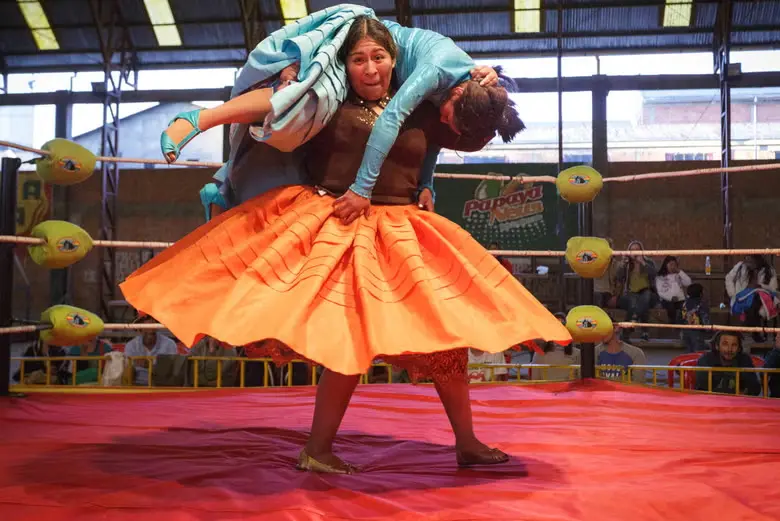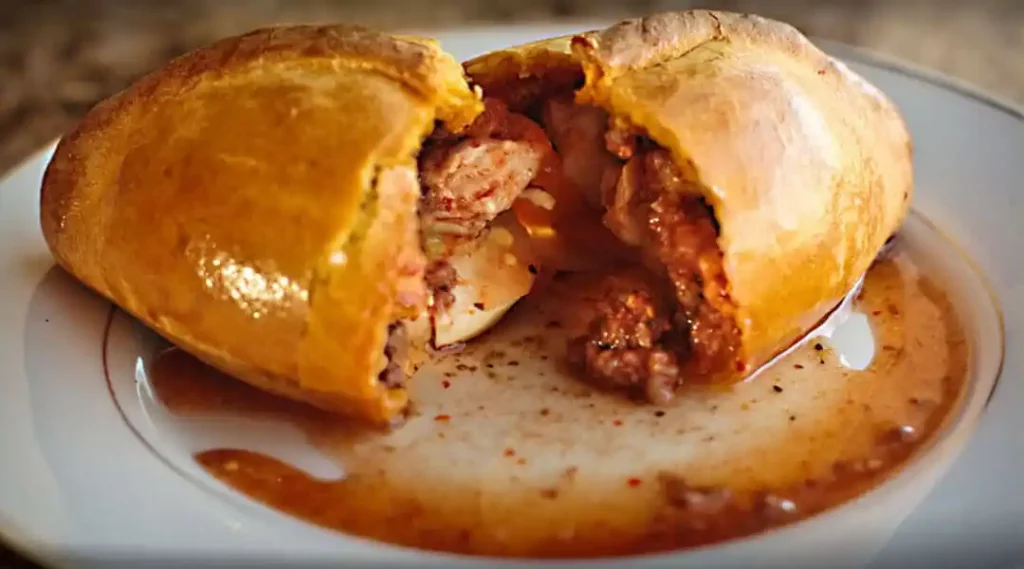The city of La Paz, located in the heart of Bolivia, is a vibrant and bustling metropolis that offers a unique blend of traditional culture and modern amenities. With its stunning mountain views, rich history, and diverse attractions, there is no shortage of things to see and do in La Paz City.
Whether you’re a nature lover, history buff, or simply looking for a new adventure, La Paz has something to offer for everyone. In this article, we will explore 10 of the top attractions and activities that you should not miss when visiting La Paz City.
What to See and Do in La Paz City
To begin with… a surprise awaits you. Or so we fear: Do you think La Paz is the capital of Bolivia? Wrong! The historical capital of Bolivia is Sucre, although La Paz hosts most government buildings and in practice, acts as the country’s most important city.
What you probably already know is that La Paz is considered the world’s highest metropolis, at over 3,600 meters above sea level. And if we move towards El Alto, the city bordering La Paz, we’ll be nearing 4,000 meters. This translates into two things: steep slopes and altitude sickness (spend a few days quietly in La Paz, to acclimatize).
Now, let’s really get to know this Bolivian city, even if it’s just virtually 😉
1. Witches’ Market (Mercado de las Brujas)
Don’t be frightened by the name; you won’t find witches brewing potions in cauldrons at the corners. But you will find small shops with potions, medicinal plants, amulets, and everything necessary for performing ancient Andean rituals. This includes the llama fetuses you’ll see hanging at the entrances of these curious shops. Apparently, they are one of the most popular “talismans” among the local population (and also quite striking to foreigners) and are commonly buried when buying a house to bring good luck.
Whether you believe in these things or are more skeptical, strolling among these outdoor stalls is undoubtedly one of the best things to do in La Paz. Moreover, if you’re lucky (or if you pay, hehe), you can attend and participate in ancestral rituals. We didn’t see anything, but we did attend a challa in the Salar de Uyuni: our guide, before having some wine, poured a little on the ground… as an offering to Pachamama.
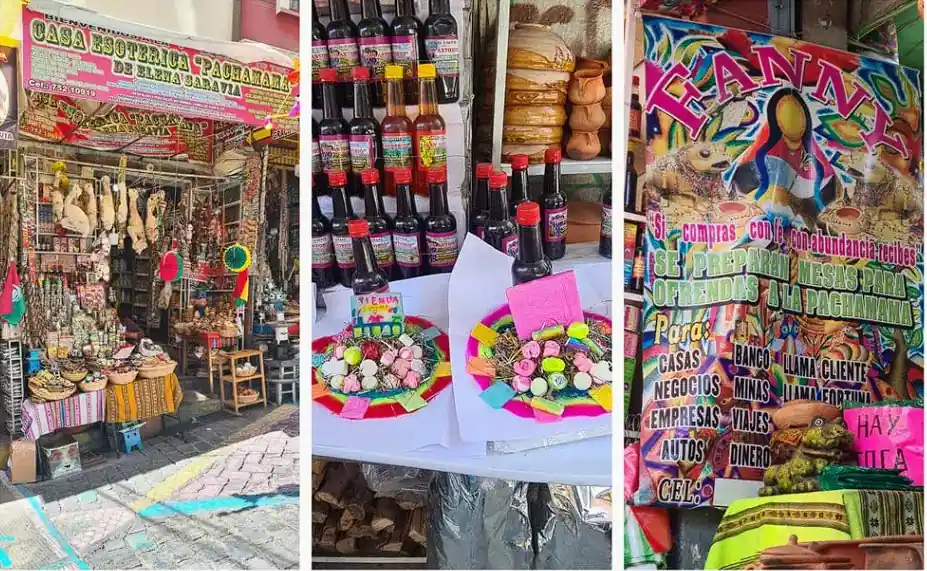
2. Sagarnaga Street (and other beautiful streets)
Right next to the alley where these ointment and potion shops are located, there are several colorful, lively little streets that exude a unique charm in the heart of La Paz’s historic center. Cobblestoned, decorated with street art, filled with craft shops, small restaurants, cafes, and even hanging umbrellas, strolling through this area of La Paz is a real delight.
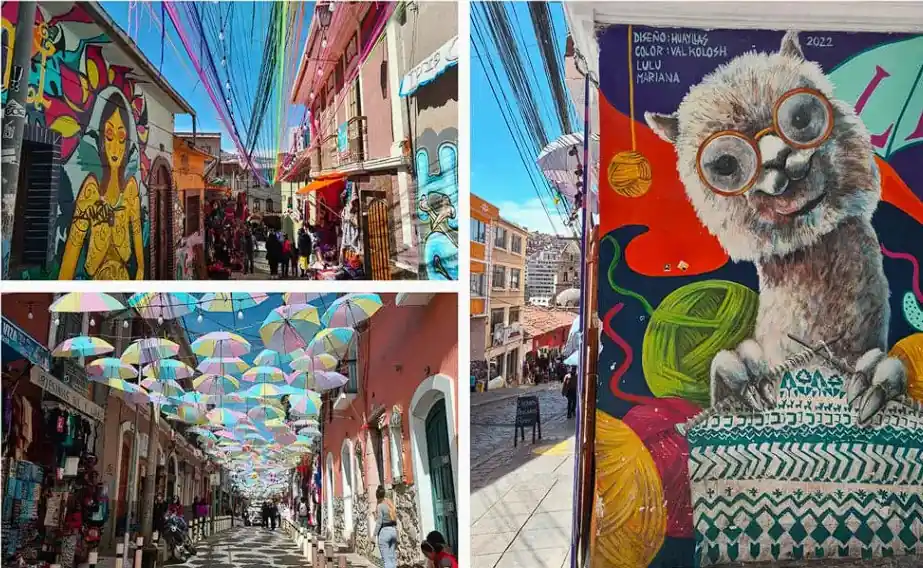
These are the streets where you can’t resist a good session of urban photography (and shopping):
- Sagarnaga Street (the most popular of all)
- Linares Street (the umbrella street)
- Melchor Jiménez Street (where the Witches’ Market is located)
It’s a great area for eating or enjoying a delicious coffee, for example, at The Carrot Tree (Western food, rich coffees, spectacular cakes, and a beautiful terrace), Café Banais (inside a well-maintained colonial house), or La Groseria (specialized in brunch and with a wide selection of beers).
3. Teleférico (Cable Car) Ride
Another must-do activity in La Paz is to take a ride on the Cable Car, one of Bolivia’s most astonishing landmarks: it currently has 10 lines (each a different color) and represents the world’s longest urban cable car network.
Inaugurated in 2014 (with the last line completed in 2019) during Evo Morales’ presidency, this cable car system was designed to connect the cities of La Paz and El Alto, aiming to solve traffic problems and improve the precarious public transportation. Today, it’s not only an ideal way to travel around the city but also a tourist attraction in itself. And it’s affordable – a single ticket costs 3 Bolivianos (about 0.43 USD at the current exchange rate), and if you want to transfer, you need to add an additional 2 Bolivianos.
The red line offers the best panoramic views, as it ascends and crosses the city of El Alto (recommended on Thursdays or Sundays when the market is set up).
But if you have time and want to do a circular route from the center of La Paz, we suggest taking the red line at the Central station, going up to the 16 de Julio station, and then switching to the silver line. It’s just 2 stops to reach the Mirador station, where you’ll connect with the yellow line, another popular choice, to fly over the Sopocachi neighborhood and get off at the Libertadores station. Finally, transfer to the blue line to end at the Prado station, not far from Sucre Square.
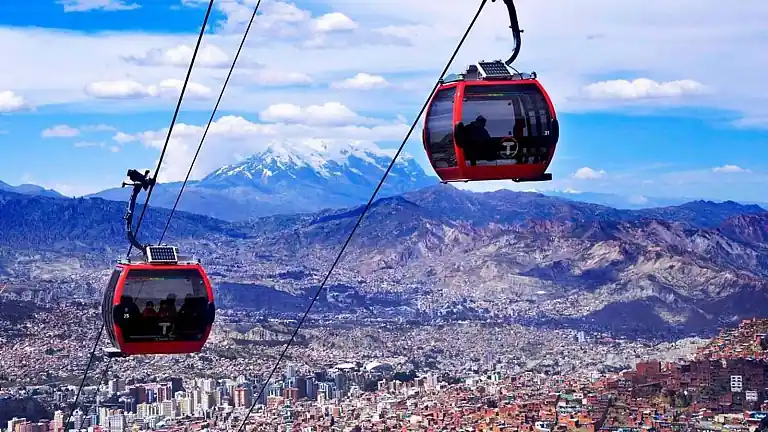
⭐ More information on the official Mi Teleférico website
4. Plaza Murillo
Another sight to see and thing to do in La Paz is to visit the old Plaza de Armas, which has been renamed Plaza Murillo in honor of Pedro Domingo Murillo, a key figure in laying the groundwork for the country’s independence, achieved in 1825. There’s a large statue of him in the center of the plaza.

It is the administrative and political heart of the city, as the Presidential Palace, the Congress of the Republic, and the Metropolitan Cathedral surround it, featuring a mix of classic and modern styles that have not thrilled all residents of La Paz.
In the same square, there are benches, ice cream and empanada vendors, and a lot of atmosphere (and pigeons, watch out for the droppings). At certain times of the day, you can witness the flag-raising and the changing of the guard by the “Colorados de Bolivia,” the presidential guard.
5. Valley of the moon
Just a short distance from La Paz City lies the Valle de la Luna (Moon Valley), a breathtaking natural wonder that resembles the lunar landscape. Explore the maze of unique rock formations and marvel at the striking beauty of this otherworldly place. Take a guided tour or simply wander through the tranquil trails to fully immerse yourself in the tranquility and serenity of Valle de la Luna.
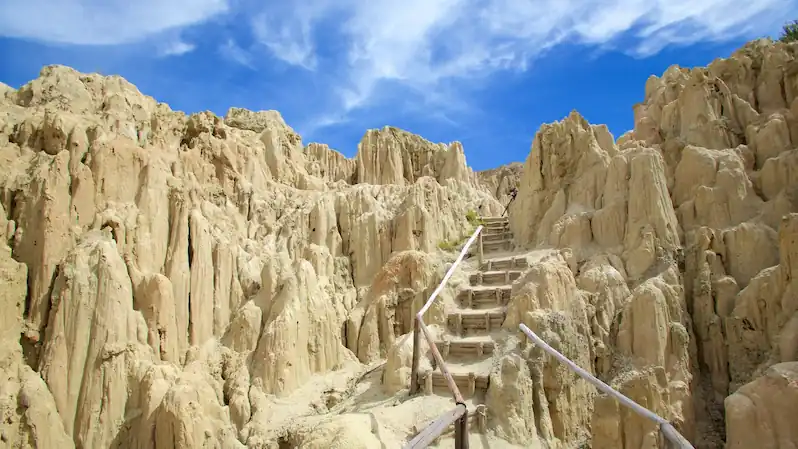
6. Explore the Local Cuisine
One of the best ways to experience the culture of La Paz City is through its vibrant and diverse food scene. Sample traditional Bolivian dishes such as salteñas (meat-filled pastries), anticuchos (grilled skewers), api (traditional corn beverage), and the famous llama meat. Explore the local markets and restaurants to indulge in the flavors of La Paz and discover new culinary delights.
La Paz, Bolivia, offers a rich and varied cuisine that reflects the country’s cultural diversity. Here is a list of typical dishes you might find in La Paz:
- Bolivian Salteñas: Juicy pastries filled with beef, chicken, or vegetables, mixed with a sweet-spicy sauce, boiled egg, olives, and raisins.
- Fricasé: A spicy, thick soup made with choclo (Andean corn), pork meat, chuño (dehydrated potato), and spices.
- Chairo: A nutritious soup made with lamb meat, chuño, vegetables, broad beans, and quinoa.
- Plato Paceño: A dish that combines broad beans, choclo, fresh cheese, and sometimes meat or fish.
- Anticuchos: Skewers of beef heart marinated in spices and grilled, usually served with potatoes and llajwa.
- Api with Pastel: A hot drink made from purple corn served with a fried pastry (often filled with cheese).
- Sajta de Pollo: A chicken stew with yellow chili and herbs, served with potatoes and rice.
- Tucumanas: Similar to salteñas but fried instead of baked.
- Humintas: A corn-based snack, similar to tamales, which can be baked or boiled.
7. Jaén Street
Often touted as the most beautiful street in La Paz, Jaén Street is enveloped in charm. With its cobblestone pathways and colorful colonial houses, it’s not just its beauty that captivates visitors, but also the air of mystery that surrounds it. Tales of spectral appearances, echoes of cries in the night, ghostly figures of ladies, and the sounds of chains dragging across the cobblestones add an intriguing layer to its allure, making it a favorite among tourists (and a perfect spot for Iker Jiménez enthusiasts).
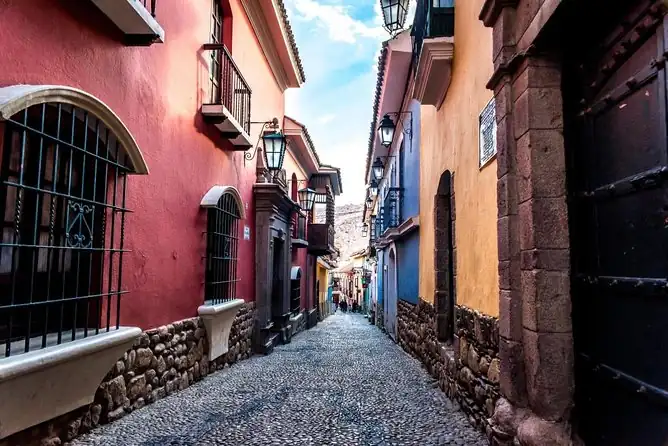
As you turn onto the street and begin to ascend, you’ll notice a green cross placed as a protective talisman, believed to ward off evil spirits. Beyond these superstitions, Jaén Street also boasts an array of quaint museums and art galleries, each offering a glimpse into the rich cultural tapestry of La Paz.”
8. Killi Killi Lookout
If you’re passionate about photography or just want to enjoy one of the best panoramic views in La Paz, you must visit the Killi Killi Viewpoint. From up there, you’ll be amazed by the distinctive relief of La Paz, and you can see in the background one of the city’s most beloved symbols: the snowy Illimani Mountain (6,460 meters high).
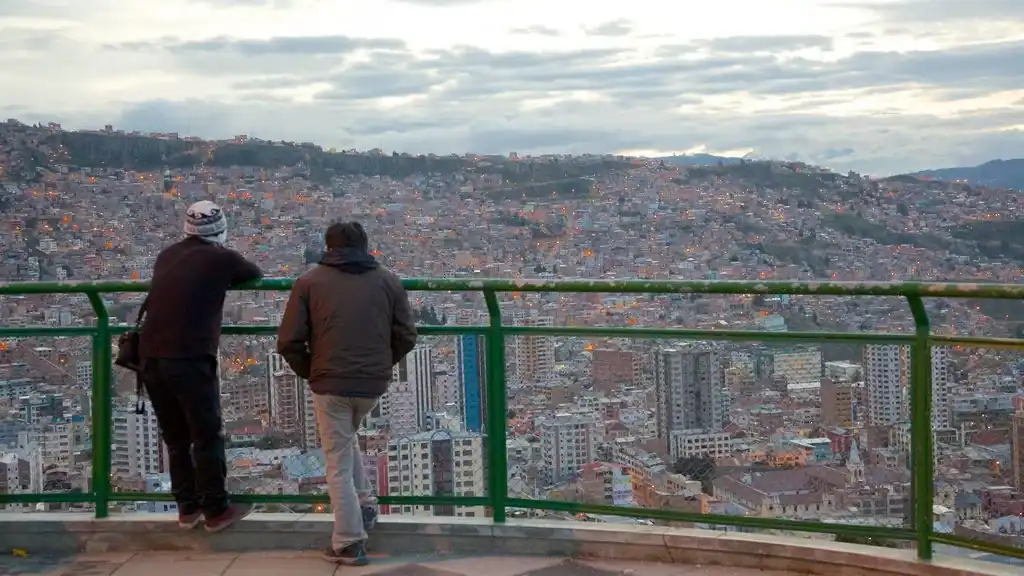
When we visited, we coincided with a political event (apparently, they were inaugurating the recent renovation), and we saw the city mayor surrounded by zebras… well, humans dressed as zebras. It was quite surreal.
To get there, you can walk, but be prepared to sweat a lot. We took a taxi (they are cheap, if I remember correctly, we paid about 15 Bolivianos from Jaén Street).”
9. San Francisco Church
Sagarnaga Street leads to one of the busiest squares in the center of La Paz, known as Plaza Mayor de los Héroes. The main attraction here is the Basilica of San Francisco, originally built between the 16th and 17th centuries but reconstructed between 1743 and 1744. It is probably the most beautiful and prominent religious temple in La Paz.

The exterior particularly stands out for its Andean Baroque (or Mestizo) style, used by indigenous sculptors to decorate the facade (if you look closely, you’ll see elements of flora and fauna typical of that style), and the striking bell tower.
Adjacent to the Basilica is another key building in the history of La Paz: the San Francisco Convent, which was the city’s first Catholic institution. Today, both buildings house the San Francisco Cultural Center and Museum, which requires an entrance fee. This center explains the city’s history and displays ancient objects and relics from the Franciscan order. Visitors can also explore various spaces, including the cloister, the crypt, and formerly the bell tower’s viewpoint.
Tips: If you enjoy visiting local markets, the Lanza Market is very close by. After a stroll there, cross the Pérez Velasco elevated walkway behind it and continue along the pedestrian and vibrant Comercio Street to reach our next stop…
10. Cholitas Wrestling
Attending a ‘cholita’ wrestling match might be a bit touristy, but it promises to be quite an experience. Cholitas Wrestling is located in El Alto, and the fights must be surreal: female wrestlers dressed in the traditional attire of ‘cholitas,’ with wide colorful skirts, wool sweaters, and distinctive braids.
Yes, the fight is more for show… but the hits and falls are real. In fact, anything goes (or almost anything) in professional wrestling. This started by chance (it is said that one of the wrestlers one day wore a skirt and the audience loved it, so it was decided that the female wrestlers would wear traditional dress), and it has become a major tourist attraction. But it’s not just that: some argue that cholitas wrestling is a powerful statement on the empowerment of Andean women.
